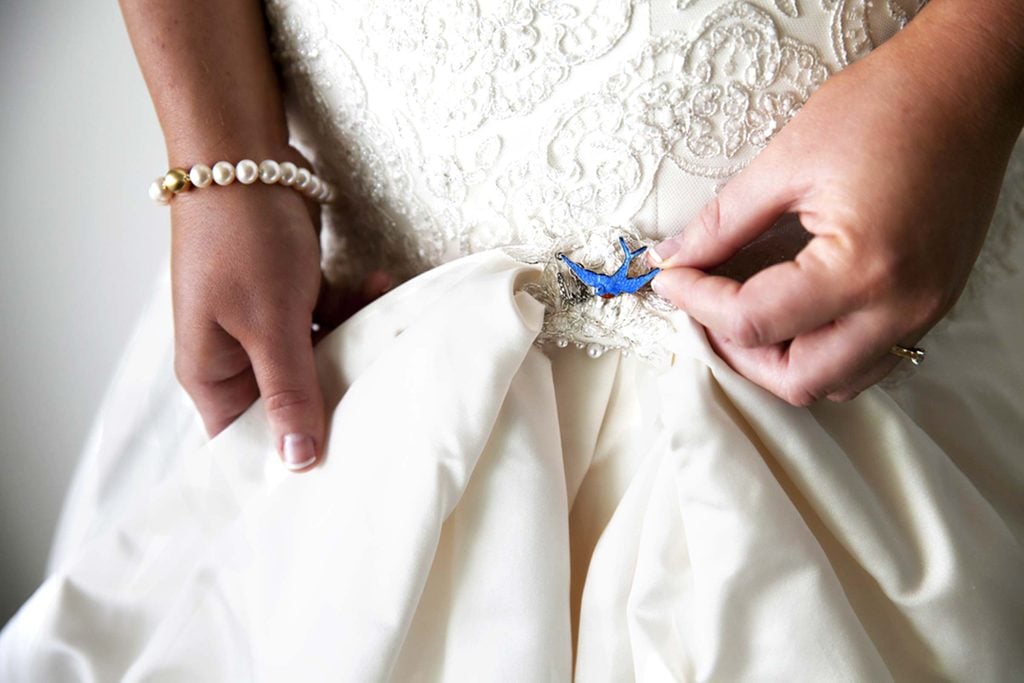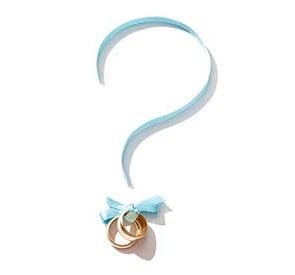Why Do Brides Need Something Old, New, Borrowed, and Blue?
Updated: Oct. 21, 2022

You've likely heard the centuries-old wedding rhyme. Here's what it means, and where it came from.
As far as wedding traditions go, they’re mostly symbolic but standard across the board: the bouquet toss, the placement of the wedding band on the ring finger, even the matching bridesmaid dresses. And you’ve likely heard the old rhyme: “Something old, something new, something borrowed, something blue, and a sixpence in your shoe.” But what does it mean, and why is it important?
We’ve gotten to the bottom of this unique wedding practice and its origins—but if you’re looking for more wedding etiquette fun facts, here’s what knee to propose on.
What does the saying “Something old, something new, something borrowed, something blue” mean?
The centuries-old wedding rhyme describes the four (technically five, if you count the oft-forgotten sixpence) objects a bride is supposed to wear or carry with her on her wedding day. But why?
While they’ve taken on slightly different meanings today, each is still deeply symbolic for brides on their special day. Because it’s such an old tradition, historians differ on the meaning, but they’re in general agreement on the interpretations, with each item given its own symbolism:
- Something old represents continuity and protection for a bride’s future child.
- Something new represents optimism for the future.
- Something borrowed represents borrowed happiness from another happily married couple or bride.
- Something blue represents purity, love, and fidelity and is also meant to ward off the Evil Eye, a curse that could make the bride infertile.
The history of something old, new, borrowed, and blue
The mantra started as a Victorian-era rhyme that came out of the English county of Lancashire, with its first documented reference being written in an 1871 issue of St. James Magazine. The goal of most of the items was to ensure healthy fertility for the bride, which could have been cursed by the Evil Eye, or the malicious eye of the bride’s former suitors.
In the 1800s, they believed that wearing these items would confuse the Evil Eye into thinking the bride was already fertile, therefore thwarting the curse, and ensuring successful pregnancies.
Who gives the bride something old, new, borrowed, and blue?
The items are generally collected from women in the bride’s family, or female friends who have had successful marriages and families. Specifically, “something borrowed” was preferably the undergarment from a woman who already had children, and “something blue” was typically a garter belt under the bride’s dress, ideally sourced from a married woman or mother.
The sixpence was traditionally given to the bride by her father to be placed in her shoe. As with most of the items, it matters less today who it comes from, and some brides make the sixpence tradition extra special by finding a coin minted in the year they were born or the year they met their spouse-to-be.
Why do brides wear sixpence in shoes?
While it isn’t always included in the rhyme today, the sixpence—an old British coin no longer in circulation—was once an important part of this wedding tradition. When a bride wore a sixpence in her shoe, it represented prosperity for the new couple’s future.
If a non-British bride is lucky enough to find a sixpence to put in her shoe, she uses it as a wish for good fortune. Today, when women do include the sixpence tradition in their special day, they’ll commonly substitute a penny or another small coin.
While wearing “something old, something new, something borrowed, and something blue” is a pretty outdated tradition, many brides still have fun with it today. For more wedding trivia, here’s what happens if someone objects at a wedding. And here’s the reason why Southern brides bury a bottle of bourbon before their wedding day.
Sources:
- Gillian Bennett, Folklore: “Charlotte Sophia Burne: Shropshire Folklorist, First Woman President of the Folklore Society, and First Woman Editor of Folklore”
- The St. James’s Magazine: Volume 7; Volume 28


